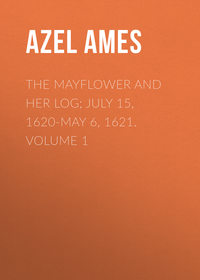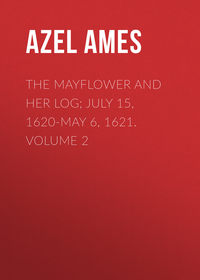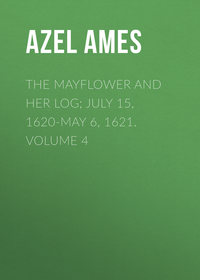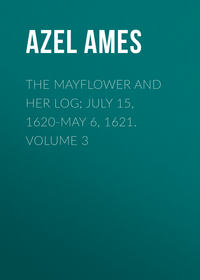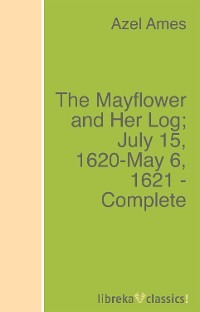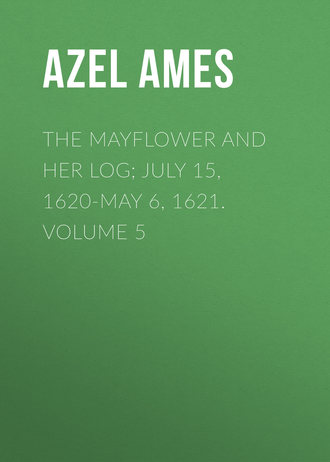 полная версия
полная версияThe Mayflower and Her Log; July 15, 1620-May 6, 1621. Volume 5
Vinegar in hogsheads was named on the food-list of every ship of the Pilgrim era. It was one of their best antiscorbutics, and was of course a prime factor in their use of "sour krout," pickling, etc. The fruits, natural, dried, and preserved, were probably, in that day, in rather small supply. Apples, limes, lemons, prunes, olives, rice, etc., were among the luxuries of a voyage, while dried or preserved fruits and small fruits were not yet in common use. Winslow, in the letter cited, urges that "your casks for beer . . . be iron bound, at least for the first [end] tyre" [hoop]. Cushman states that they had ample supplies of beer offered them both in Kent and Amsterdam. The planters' supply seems to have failed, however, soon after the company landed, and they were obliged to rely upon the whim of the Captain of the MAY-FLOWER for their needs, the ship's supply being apparently separate from that of the planters, and lasting longer. Winthrop's supply seems to have been large ("42 tons"—probably tuns intended). It was evidently a stipulation of the charter-party that the ship should, in part at least, provision her crew for the voyage,—certainly furnish their beer. This is rendered certain by Bradford's difficulty (as stated by himself) with Captain Jones, previously referred to, showing that the ship had her own supply of beer, separate from that of the colonists, and that it was intended for the seamen as well as the officers.
Bradford mentions "aqua vitae" as a constituent of their lunch on the exploring party of November 15. "Strong waters" (or Holland gin) are mentioned as a part of the entertainment given Massasoit on his first visit, and they find frequent mention otherwise. Wine finds no mention. Bradford states in terms: "Neither ever had they any supply of foode from them [the Adventurers] but what they first brought with them;" and again, "They never had any supply of vitales more afterwards (but what the Lord gave them otherwise), for all ye company [the Adventurers] sent at any time was allways too short for those people yt came with it."
The clothing supplies of the Pilgrims included hats, caps, shirts, neck- cloths, jerkins, doublets, waistcoats, breeches (stuff and leather), "hosen," stockings, shoes, boots, belts (girdles), cloth, piece-goods (dress-stuff's), "haberdasherie," etc., etc., all of which, with minor items for men's and women's use, find mention in their early narratives, accounts, and correspondence. By the will of Mr. Mullens it appears that he had twenty-one dozen of shoes and thirteen pairs of boots on board, doubtless intended as medium of exchange or barter. By the terms of the. contract with the colonists, the Merchant Adventurers were to supply all their actual necessities of Clothing food, clothing, etc., for the full term of seven years, during which the labors of the "planters" were to be for the joint account. Whether under this agreement they were bound to fully "outfit" the colonists before they embarked (and did so), as was done by Higginson's company coming to Salem in 1628-29 at considerable cost per capita, and as was done for those of the Leyden people who came over in 1629 with Pierce in the MAY-FLOWER and the TALBOT to Salem, and again in 1630 with the same Master (Pierce) in the LION by the Plymouth successors to the Adventurers (without recompense), does not clearly appear. No mention is found of any "outfitting" of the MAY-FLOWER passengers except the London apprentices. There is no doubt that a considerable supply of all the above-named articles was necessarily sent by the Adventurers on the MAY-FLOWER, both for the Pilgrims' needs on the voyage and in the new colony, as also for trading purposes. There seems to have been at all times a supreme anxiety, on the part of both Pilgrim and Puritan settlers, to get English clothes upon their red brethren of the forest, whether as a means of exchange for peltry, or for decency's sake, is not quite clear. There was apparently a greater disparity in character, intelligence, and station between the leaders of Higginson's and Winthrop's companies and their followers than between the chief men of the Pilgrims and their associates. With the former were titles and considerable representation of wealth and position. With the passengers of the MAY-FLOWER a far greater equality in rank, means, intelligence, capacity, and character was noticeable. This was due in part, doubtless, to the religious beliefs and training of the Leyden contingent, and had prompt illustration in their Compact, in which all stood at once on an equal footing. There was but little of the "paternal" nature in the form of their government (though something at times in their punishments), and there was much personal dignity and independence of the indi vidual. An equipment having so much of the character of a uniform—not to say "livery "—as that furnished by Higginson's company to its people suggests the "hedger and ditcher" type of colonists (of whom there were very few among the Plymouth settlers), rather than the scholar, publisher, tradesman, physician, hatter, smith, carpenter, "lay reader," and soldier of the Pilgrims, and would certainly have been obnoxious to their finer sense of personal dignity and proportion. Doubtless an equivalent provision existed—though in less "all-of-a-pattern " character—in the bales and boxes of the MAY-FLOWER'S cargo for every need suggested by the list of the Higginson "outfit," which is given herewith, both as matter of interest and as affording an excellent idea of the accepted style and needs in dress of a New England settler (at least of the men) of 1620-30. One cannot fail to wonder at the noticeably infrequent mention of provision in apparel, etc., for the women and children. The inventory of the "Apparell for 100 men" furnished by Higginson's company in 1628-29 gives us, among others, the following items of clothing for each emigrant:– 4 "peares of shoes." 4 "peares of stockings." 1 "peare Norwich gaiters." 4 "shirts." 2 "suits dublet and hose of leather lyn'd with oyld skyn leather, ye hose & dublett with hooks & eyes." 1 "sute of Norden dussens or hampshire kersies lynd the hose with skins, dublets with lynen of gilford or gedlyman kerseys." 4 bands. 2 handkerchiefs. 1 "wastecoat of greene cotton bound about with red tape." 1 leather girdle. 1 "Monmouth cap." 1 "black hatt lyned in the brows with lether." 5 "Red knitt capps milf'd about 5d apiece." 2 "peares of gloves." 1 "Mandiliion lynd with cotton" [mantle or greatcoat]. 1 "peare of breeches and waistcoat." 1 "leather sute of Dublett & breeches of oyled leather." 1 "peare of leather breeches and drawers to weare with both there other sutes."
In 1628 Josselyn put the average cost of clothing to emigrants to New
England at L4 each. In 1629 good shoes cost the "Bay" colonists 2s/7d
per pair. In his "Two Voyages to New England "previously referred to,
Josselyn gives an estimate (made about 1628) of the "outfit" in clothing
needed by a New England settler of his time. He names as "Apparel for
one man—and after this rate for more:—"
One Hatt
One Monmouth Cap
Three falling bands
Three Shirts
One Wastcoat
One Suite of Frize (Frieze)
One Suite of Cloth
One Suite of Canvas
Three Pairs of Irish Stockings
Four Pairs of Shoes
One Pair of Canvas Sheets
Seven ells of coarse canvas, to make a bed at sea for two men,
to be filled with straw
One Coarse Rug at Sea
The Furniture of the Pilgrims has naturally been matter of much interest to their descendants and others for many years. While it is doubtful if a single article now in existence can be positively identified and truthfully certified as having made the memorable voyage in the MAY- FLOWER (nearly everything having, of course, gone to decay with the wear and tear of more than two hundred and fifty years), this honorable origin is still assigned to many heirlooms, to some probably correctly. Dr. Oliver Wendell Holmes in his delightful lines, "On Lending a Punch Bowl," humorously claims for his convivial silver vessel a place with the Pilgrims:—
"Along with all the furniture, to fill their new abodes,To judge by what is still on hand, at least a hundred loads."To a very few time-worn and venerated relics—such as Brewster's chair and one or more books, Myles Standish's Plymouth sword, the Peregrine White cradle, Winslow's pewter, and one or two of Bradford's books—a strong probability attaches that they were in veritate, as traditionally avowed, part of the MAY-FLOWER'S freight, but of even these the fact cannot be proven beyond the possibility of a doubt.
From its pattern and workmanship, which are of a period antedating the "departure from Delfshaven," and the ancient tradition which is traceable to Brewster's time, it appears altogether probable that what is known as "Elder Brewster's chair" came with him on the ship. There is even greater probability as to one of his books bearing his autograph.
The sword of Myles Standish, in possession of the Pilgrim Society, may claim, with equal probability, MAY-FLOWER relation, from its evident antiquity and the facts that, as a soldier, his trusty blade doubtless stayed with him, and that it is directly traceable in his descendants' hands, back to his time; but an equally positive claim is made for similar honors for another sword said to have also belonged to the Captain, now in the keeping of the Massachusetts Historical Society.
The Peregrine White cradle "is strongly indorsed as of the MAY-FLOWER, from the facts that it is, indubitably, of a very early Dutch pattern and manufacture; that Mrs. White was anticipating the early need of a cradle when leaving Holland; and that the descent of this one as an heirloom in her (second) family is so fairly traced."
The pewter and the silver flask of Winslow not only bear very early "Hallmarks," but also the arms of his family, which it is not likely he would have had engraved on what he may have bought after notably becoming the defender of the simplicity and democracy of the "Pilgrim Republic." Long traceable use in his family strengthens belief in the supposition that these articles came with the Pilgrims, and were then very probably heirlooms. One of Governor Bradford's books (Pastor John Robinson's "Justification of Separation"), published in 1610, and containing the Governor's autograph, bears almost 'prima facie' evidence of having come with him in the MAY-FLOWER, but of course might, like the above-named relics, have come in some later ship.
In this connection it is of interest to note what freight the MAY-FLOWER carried for the intellectual needs of the Pilgrims. Of Bibles, as the "book of books," we may be sure—even without the evidence of the inventories of the early dead—there was no lack, and there is reason to believe that they existed in several tongues, viz. in English, Dutch, and possibly French (the Walloon contribution from the Huguenots), while there is little doubt that, alike as publishers and as "students of the Word," Brewster, Bradford, and Winslow, at least, were possessed of, and more or less familiar with, both the Latin and Greek Testaments. It is altogether probable, however, that Governor Bradford's well attested study of "the oracles of God in the original" Hebrew, and his possession of the essential Hebrew Bible, grammar, and lexicon, were of a later day. Some few copies of the earliest hymnals ("psalme-bookes")—then very limited in number—there is evidence that the Holland voyagers had with them in the singing of their parting hymns at Leyden and Delfshaven, as mentioned by Winslow and in the earlier inventories: These metrical versions of the Psalms constituted at the time, practically, the only hymnology permitted in the worship of the "Separatists," though the grand hymn of Luther, "Ein feste Burg ist unser Gott," doubtless familiar to them, must have commended itself as especially comforting and apposite.
Of the doctrinal tracts of their beloved Pastor, John Robinson, there is every probability, as well as some proof, that there was good supply, as well as those of Ainsworth and Clyfton and of the works of William Ames, the renowned Franeker Professor, the controversial opponent but sincere friend of Robinson: the founder of evangelical "systematic theology," [method—Methodist? D.W.] whom death alone prevented from becoming the President of Harvard College. We may be equally sure that the few cases of books in the freight of the Pilgrim ship included copies of the publications of the "hidden and hunted press" of Brewster and Brewer, and some at least of the issues of their fellows in tribulation at Amsterdam and in Scotland and England. Some few heavy tomes and early classics in English, Dutch, Latin, and Greek were also presumably among the goodly number of books brought in the MAY FLOWER by Brewster, Bradford, Winslow, Fuller, Hopkins, Allerton, Standish, and others, though it is probable that the larger part of the very considerable library of four hundred volumes, left at his death by Brewster (including sixty-two in Latin), and of the respectable libraries of Fuller, Standish, and others, named in their respective inventories, either were brought over in the later ships, or were the products of the earliest printers of New England. One is surprised and amused that the library of the good Dr. Fuller should contain so relatively small a proportion of medical works (although the number in print prior to his death in 1633 was not great), while rich in religious works pertinent to his functions as deacon. It is equally interesting to note that the inventory of the soldier Standish should name only one book on military science, "Bariffe's Artillery," though it includes abundant evidence to controvert, beyond reasonable doubt, the suggestion which has been made, that he was of the Romanist faith. Just which of the books left by the worthies named, and others whose inventories we possess, came with them in the Pilgrim ship, cannot be certainly determined, though, as before noted, some still in existence bear intrinsic testimony that they were of the number. There is evidence that Allerton made gift of a book to Giles Heale of the MAY-FLOWER (perhaps the ship's surgeon), while the ship lay at Plymouth, and Francis Cooke's inventory includes "1 great Bible and 4 olde bookes," which as they were "olde," and he was clearly not a book-buyer, very probably came with him in the ship. In fact, hardly an adult of the Leyden colonists, the inventory of whose estate at death we possess, but left one or more books which may have been his companions on the voyage.
Some of the early forms of British and Dutch calendars, "annuals," and agricultural "hand-books," it is certain were brought over by several families, and were doubtless much consulted and well-thumbed "guides, counsellors, and friends" in the households of their possessors. The great preponderance of reading matter brought by the little colony was, however, unquestionably of the religious controversial order, which had been so much a part of their lives, and its sum total was considerable. There are intimations, in the inventories of the Fathers, of a few works of historical cast, but of these not many had yet been printed. "Caesar's Commentaries," a "History of the World," and a "History of Turkey" on Standish's shelves, with the two Dictionaries and "Peter Martyr on Rome" on Dr. Fuller's, were as likely to have come in the first ship, and to have afforded as much satisfaction to the hungry readers of the little community as any of the books we find named in the lists of their little stock. It is pathetic to note, in these days of utmost prodigality in juvenile literature, that for the Pilgrim children, aside from the "Bible stories," some of the wonderful and mirth-provoking metrical renderings of the "Psalme booke," and the "horne booke," or primer (the alphabet and certain elementary contributions in verse or prose, placed between thin covers of transparent horn for protection), there was almost absolutely nothing in the meagre book-freight of the Pilgrim ark. "Milk for Babes," whether as physical or mental pabulum, was in poor supply aboard the MAY-FLOWER.
The most that can be claimed with confidence, for particular objects of alleged MAY-FLOWER relation, is that there is logical and moral certainty that there was a supply of just such things on board, because they were indispensable, and because every known circumstance and condition indicates their presence in the hands to which they are assigned, while tradition and collateral evidence confirm the inference and sometimes go very far to establish their alleged identity, and their presence with their respective owners upon the ship. A few other articles besides those enumerated in possession of the Pilgrim Society, and of other societies and individuals, present almost equally strong claims with those named, to be counted as "of MAY-FLOWER belonging," but in no case is the connection entirely beyond question. Where so competent, interested, and conscientious students of Pilgrim history as Hon. William T. Davis, of Plymouth, and the late Dr. Thomas B. Drew, so long the curator of the Pilgrim Society, cannot find warrant for a positive claim in behalf of any article as having come, beyond a doubt, "in the MAY FLOWER," others may well hesitate to insist upon that which, however probable and desirable, is not susceptible of conclusive proof.
That certain articles of household furniture, whether now existent or not, were included in the ship's cargo, is attested by the inventories of the small estates of those first deceased, and, by mention or implication, in the narratives of Bradford, Winslow, Morton, and other contemporaries, as were also many utensils and articles of domestic use. There were also beyond question many not so mentioned, which may be safely named as having very certainly been comprised in the ship's lading, either because in themselves indispensable to the colonists, or because from the evidence in hand we know them to have been inseparable from the character, social status, daily habits, home life, or ascertained deeds of the Pilgrims. When it is remembered that furnishings, however simple, were speedily required for no less than nineteen "cottages" and their households, the sum total called for was not inconsiderable.
[Bradford, in Mourt's Relation (p. 68), shows that the colonists were divided up into "nineteen families," that "so we might build fewer houses." Winslow, writing to George Morton, December 11/21, 1621, says: "We have built seven dwelling-houses and four for the use of the plantation." Bradford (Historie, Mass. ed. p. 110) calls the houses "small cottages."]
Among the furniture for these "cottages" brought on the Pilgrim ship may be enumerated: chairs, table-chairs, stools and forms (benches), tables of several sizes and shapes (mostly small), table-boards and "cloathes," trestles, beds; bedding and bed-clothing, cradles, "buffets," cupboards and "cabinets," chests and chests of drawers, boxes of several kinds and "trunks," andirons, "iron dogs," "cob-irons," fire-tongs and "slices" (shovels), cushions, rugs, and "blanckets," spinning wheels, hand-looms, etc., etc. Among household utensils were "spits," "bake-kettles," pots and kettles (iron, brass, and copper), frying-pans, "mortars" and pestles (iron, brass, and "belle-mettle"), sconces, lamps (oil "bettys"), candlesticks, snuffers, buckets, tubs, "runlets," pails and baskets, "steel yards," measures, hour-glasses and sun-dials, pewter-ware (platters, plates, mugs, porringers, etc.), wooden trenchers, trays, "noggins," "bottles," cups, and "lossets." Earthen ware, "fatten" ware (mugs, "jugs," and "crocks "), leather ware (bottles, "noggins," and cups), table-ware (salt "sellars," spoons, knives, etc), etc. All of the foregoing, with numerous lesser articles, have received mention in the early literature of the Pilgrim exodus, and were undeniably part of the MAY-FLOWER'S lading.
The MAY-FLOWER origin claimed for the "Governor Carver chair" and the "Elder Brewster chair" rests wholly upon tradition, and upon the venerable pattern and aspect of the chairs themselves. The "Winslow chair," in possession of the Pilgrim Society at Plymouth (Mass.), though bearing evidence of having been "made in Cheapside, London, in 1614," is not positively known to have been brought on the MAY-FLOWER. Thacher's "History of Plymouth" (p. 144.) states that "a sitting-chair, said to have been screwed to the floor of the MAY-FLOWER'S cabin for the convenience of a lady, is known to have been in the possession of Penelope Winslow (who married James Warren), and is now in possession of Hannah White." There are certain venerable chairs alleged, with some show of probability, to have been the property of Captain Standish, now owned in Bridgewater, but there is no record attached to them, and they are not surely assignable to either ship or owner. That some few tables —mostly small—were brought in the MAY-FLOWER, there is some evidence, but the indications are that what were known as "table-boards"—long and narrow boards covered with what were called "board-cloths"—very largely took the place of tables. The walnut-top table, said to have once been Governor Winslow's and now in possession of the Pilgrim Society, is not known to have come over with him, and probably did not. It was very likely bought for the use of the Council when he was governor. The "table-boards" mentioned were laid on "trestles" (cross-legged and folding supports of proper height), which had the great merit that they could be placed in any convenient spot and as easily folded up, and with the board put away, leaving the space which a table would have permanently occupied free for other use.
Bradford mentions that when the fire of Sunday, January 14., 1621, occurred in the "common house," the "house was as full of beds as they could lie one by another." There is a doubt, however, whether this indicates bedsteads or (probably) "pallets" only. Beds, bedding of all sorts, pillow-"beers," pillow-cases and even "mattrises," are of most frequent mention in the earliest wills and inventories. (See Appendix.) "Buffets," "cupboards," and "cabinets," all find mention in the earliest writers and inventories, and one or two specimens, for which a MAY-FLOWER history is claimed, are in possession of the Pilgrim Society and others. The "White" cabinet, of putative MAY-FLOWER connection, owned by the Pilgrim Society, is a fine example of its class, and both its "ear marks" and its known history support the probable truth of the claim made for it. Of "chests" and "chests-of-drawers" there were doubtless goodly numbers in the ship, but with the exception of a few chests (or the fragments of them), for which a MAY-FLOWER passage is vaunted, little is known of them. The chest claimed to be that of Elder Brewster, owned by the Connecticut Historical Society, was not improb ably his, but that it had any MAY-FLOWER relation is not shown. A fragment of a chest claimed to have been "brought by Edward Winslow in the MAY-FLOWER" is owned by the Pilgrim Society, and bears considerable evidence of the probable validity of such claim, but proof positive is lacking. Boxes of several kinds and sizes were part of the Pilgrims' chattels on their ship, some of them taking the place of the travellers' "trunks" of to-day, though "trunks" were then known by that name and find early mention in Pilgrim inventories, and there were no doubt some upon the Pilgrim ship. A few claiming such distinction are exhibited, but without attested records of their origin.
"Andirons, fire-dogs, and cob-irons" (the latter to rest roasting spits upon) were enumerated among the effects of those early deceased among the Pilgrims, rendering it well-certain that they must have been part of their belongings on the MAY-FLOWER. Fire-tongs and "slices" [shovels] are also frequently mentioned in early Pilgrim inventories, placing them in the same category with the "andirons and fire-dogs."
In "Mourt's Relation," in the accounts given of the state reception of Massasoit, "a green rug and three or four cushions" are shown to have performed their parts in the official ceremonies, and were, of course, necessarily brought in the MAY-FLOWER.
Spinning-wheels and hand-looms were such absolute necessities, and were so familiar and omnipresent features of the lives and labors of the Pilgrim housewives and their Dutch neighbors of Leyden, that we should be certain that they came with the Pilgrims, even if they did not find mention in the earliest Pilgrim inventories. Many ancient ones are exhibited in the "Old Colony," but it is not known that it is claimed for any of them that they came in the first ship. It is probable that some of the "cheese fatts" and churns so often named in early inventories came in the ship, though at first there was, in the absence of milch kine, no such use for them as there had been in both England and Holland, and soon was in New England.




